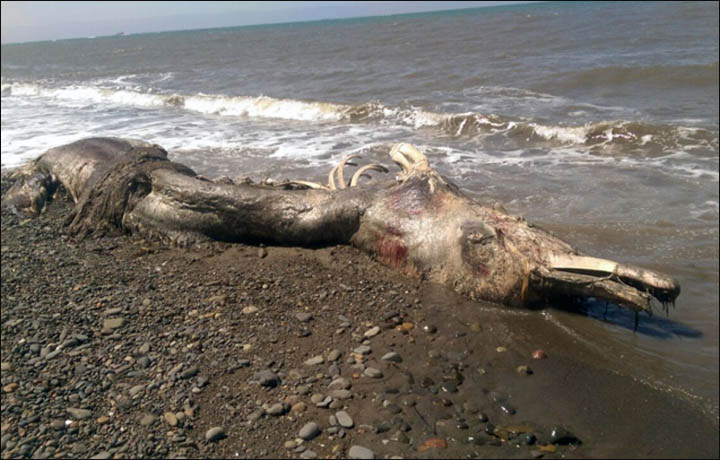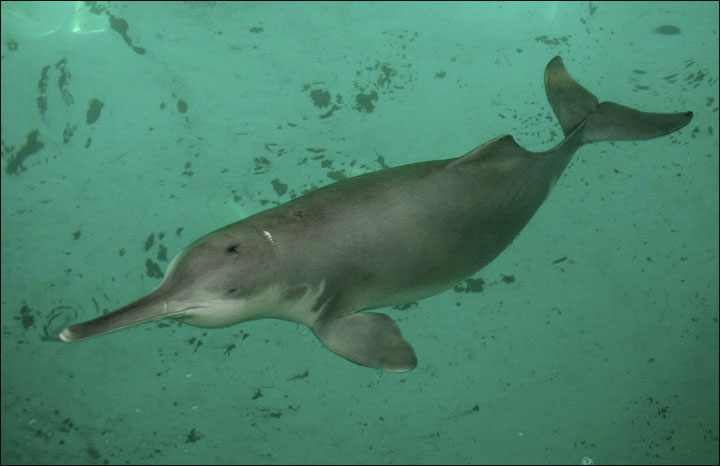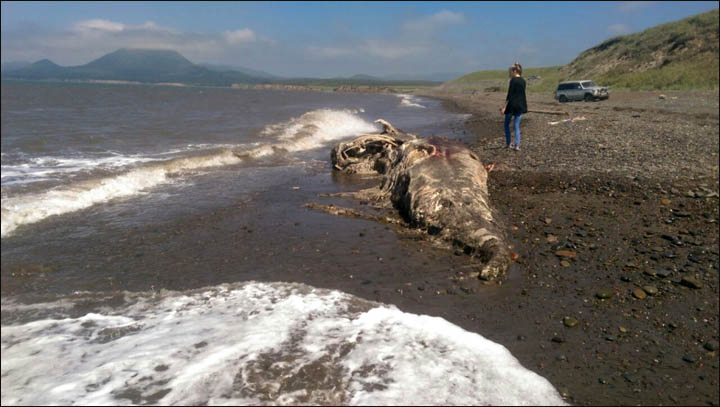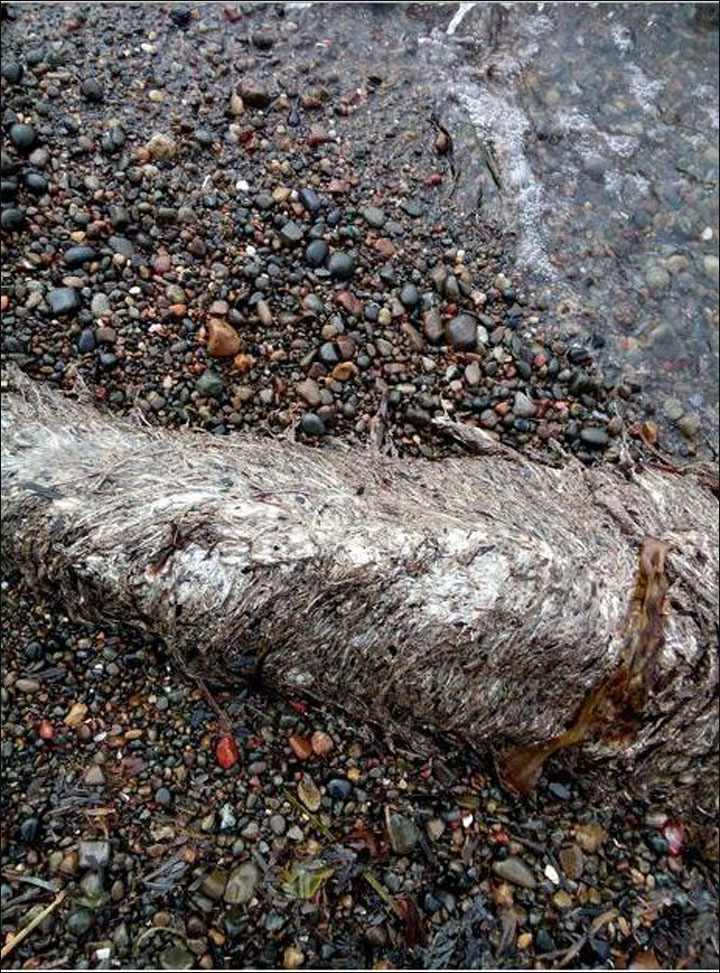It looks like you're using an Ad Blocker.
Please white-list or disable AboveTopSecret.com in your ad-blocking tool.
Thank you.
Some features of ATS will be disabled while you continue to use an ad-blocker.
12
share:
Haven't posted in a while. Randomly found this. Did a search, didn't find anything. Maybe hoax? I think it's odd mainly due to it's size. Seems to
been reported on in the last few days.

siberiantimes.com...
It does resemble a dolphin.

In fact some have said it resembles the South Asian river Dolphin except this appears to be way larger.

Also there may or may not be "fur" located on the rear side.

I don't know, that's why I came here after finding it to see what you gals/gents think. I am surprised there hasn't been a post on this yet. It could be a new species of something, maybe dolphin. The thing about it being south Asian, it is way off course plus the size of it compared to the South Asian dolphin.
The source I found this on states that the Deputy Head of the Forecasting department of the Sakhalin Research Institute of Fisheries and Oceanography, Nikolay Kim was quoted:
So the fur is odd, perhaps just an item stuck to an extremely large dolphin...?
I wouldn't be surprised if this is completely hoaxed...but you never know.

Source:
The remains of an unidentified sea animal with fur on its tail have been washed ashore in the Far East. Found near the airport at Shakhtersk, on Sakhalin Island, its appearance is unlike anything ever found in Russia.
siberiantimes.com...
It does resemble a dolphin.

In fact some have said it resembles the South Asian river Dolphin except this appears to be way larger.
source
The South Asian river dolphin (Platanista gangetica) is a freshwater or river dolphin found in India, Bangladesh, Nepal and Pakistan which is split into two subspecies, the Ganges river dolphin (P. g. gangetica) and Indus river dolphin (P. g. minor).[ The Ganges river dolphin is primarily found in the Ganges and Brahmaputra Rivers and their tributaries in Bangladesh, India and Nepal, while the Indus river dolphin is found in the Indus River in Pakistan and its Beas and Sutlej tributaries. From the 1970s until 1998, they were regarded as separate species; however, in 1998, their classification was changed from two separate species to subspecies of a single species (see taxonomy below). The Ganges river dolphin has been recognized by the government of India as its National Aquatic Animal.

same source
The South Asian river dolphin has the long, pointed nose characteristic of all river dolphins. Its teeth are visible in both the upper and lower jaws even when the mouth is closed. The teeth of young animals are almost an inch long, thin and curved; however, as animals age, the teeth undergo considerable changes and in mature adults become square, bony, flat disks. The snout thickens towards its end. The species does not have a crystalline eye lens, rendering it effectively blind, although it may still be able to detect the intensity and direction of light. Navigation and hunting are carried out using echolocation. They are unique among cetaceans in that they swim on their sides. The body is a brownish color and stocky at the middle. The species has only a small, triangular lump in the place of a dorsal fin. The flippers and tail are thin and large in relation to the body size, which is about 2-2.2 meters in males and 2.4-2.6 m in females. The oldest recorded animal was a 28-year-old male, 199 cm in length. Mature adult females are larger than males. Sexual dimorphism is expressed after females reach about 150 cm (59 in); the female rostrum continues to grow after the male rostrum stops growing, eventually reaching approximately 20 cm (7.9 in) longer.
Also there may or may not be "fur" located on the rear side.

I don't know, that's why I came here after finding it to see what you gals/gents think. I am surprised there hasn't been a post on this yet. It could be a new species of something, maybe dolphin. The thing about it being south Asian, it is way off course plus the size of it compared to the South Asian dolphin.
The source I found this on states that the Deputy Head of the Forecasting department of the Sakhalin Research Institute of Fisheries and Oceanography, Nikolay Kim was quoted:
'Judging by the appearance of the head, this is clearly some big dolphin. According to a characteristic of the skin, it is a rare species. 'I doubt that it lived in our waters. Most likely, the animal was brought by the warm current. Here often appear tropical and subtropical species. On cooling, they stay here and then die.
'I can confidently say that this is some kind of a dolphin. However, it has fur. It's unusual. Dolphins do not have any fur.'
So the fur is odd, perhaps just an item stuck to an extremely large dolphin...?
I wouldn't be surprised if this is completely hoaxed...but you never know.
Looks like a genetic chimera. It's some sort of mutation...from a dolphin.
Reminds me of Trunko
Trunko
It was connective tissue that looked like fur apparently.
Trunko
The creature reputedly washed up on Margate Beach but despite being there for 10 days, no scientist ever investigated the carcass while it was beached, so no reliable description has been published, and until September 2010 it was assumed that no photographs of it had ever been published. Some people who have never been identified were reported to have described the animal as possessing snowy-white fur, an elephantine trunk, a lobster-like tail, and a carcass devoid of blood.
It was connective tissue that looked like fur apparently.
edit on 7/2/15 by Vasa Croe because: (no reason given)
a reply to: mcx1942
It has been posted on IFLscience for a couple days. River dolphin has been one idea, but many in the field seem to think it is most likely a mammoth species that was encapsulated in ice that has recently receded from warming and the carcas drifted there.
Dolphin or Mammoth? Bizarre Creature With "Fur and a Beak" Washes up Along Russian Shore
It has been posted on IFLscience for a couple days. River dolphin has been one idea, but many in the field seem to think it is most likely a mammoth species that was encapsulated in ice that has recently receded from warming and the carcas drifted there.
Dolphin or Mammoth? Bizarre Creature With "Fur and a Beak" Washes up Along Russian Shore
edit on 2-7-2015 by grimpachi because: spelling
Does anyone know if there was a prehistoric species of dolphine/whale that would have had some sort of coat on it?
Looking at the size of the thing, it could be any of the 22 known species of beaked whales. They range in length from 4 to 13 meters.
a reply to: Macenroe82
I do know that the ancestors of Dolphins and Whales millions of years ago was a wolf-like animal that lived on land.
I do know that the ancestors of Dolphins and Whales millions of years ago was a wolf-like animal that lived on land.
originally posted by: grimpachi
a reply to: mcx1942
It has been posted on IFLscience for a couple days. River dolphin has been one idea, but many in the field seem to think it is most likely a mammoth species that was encapsulated in ice that has recently receded from warming and the carcas drifted there.
Dolphin or Mammoth? Bizarre Creature With "Fur and a Beak" Washes up Along Russian Shore
The ocean depths are warming, thus the thawing of methane hydrates. Ancient gas that has been frozen for eons is melting so it's no surprise that ancient frozen animals may thaw as well. I like your explanation the best Grimpachi.
most likely fukushima ,but this will be denied,,radiation mutates d.n.a this is a fact .i imagine they will start collecting the carcases that wash up
so as to pretend nothing is happening .
new topics
-
No, the election results aren't reminiscent of 1930s Germany. But this is.
US Political Madness: 1 hours ago -
Agree or Disagree
2024 Elections: 2 hours ago -
Leaving the US due to severe TDS?
US Political Madness: 3 hours ago
top topics
-
Where ARE the 20 million votes??? Where ARE they????? WHERE???
US Political Madness: 15 hours ago, 29 flags -
Just a thought by Matt Walsh on the election
2024 Elections: 12 hours ago, 20 flags -
The Democratic Party’s Stay Behind Program
US Political Madness: 16 hours ago, 14 flags -
President-Elect DONALD TRUMP's 2nd-Term Administration Takes Shape.
Political Ideology: 16 hours ago, 14 flags -
Liberal women going on sex strike over Trump win
US Political Madness: 13 hours ago, 12 flags -
Leaving the US due to severe TDS?
US Political Madness: 3 hours ago, 9 flags -
Celestial Objects in Far Northern Reaches of Alaska (Polar Mystery)
Fragile Earth: 17 hours ago, 7 flags -
No, the election results aren't reminiscent of 1930s Germany. But this is.
US Political Madness: 1 hours ago, 5 flags -
Agree or Disagree
2024 Elections: 2 hours ago, 4 flags -
Trump's truth and reconciliation commission
Politicians & People: 13 hours ago, 2 flags
active topics
-
Post A Funny (T&C Friendly) Pic Part IV: The LOL awakens!
General Chit Chat • 7757 • : baddmove -
On Nov. 5th 2024 - AMERICANS Prevented the Complete Destruction of America from Within.
2024 Elections • 129 • : Irishhaf -
Liberal women going on sex strike over Trump win
US Political Madness • 49 • : grey580 -
Leaving the US due to severe TDS?
US Political Madness • 14 • : Kaiju666 -
The best Songs about War.
Music • 346 • : Hellmutt -
About that ''Iron Dome''
Other Current Events • 42 • : McGinty -
No, the election results aren't reminiscent of 1930s Germany. But this is.
US Political Madness • 2 • : ColeYounger2 -
Where is Kamala?
US Political Madness • 70 • : marg6043 -
Just a thought by Matt Walsh on the election
2024 Elections • 6 • : xuenchen -
President-Elect DONALD TRUMP's 2nd-Term Administration Takes Shape.
Political Ideology • 42 • : RazorV66
12
